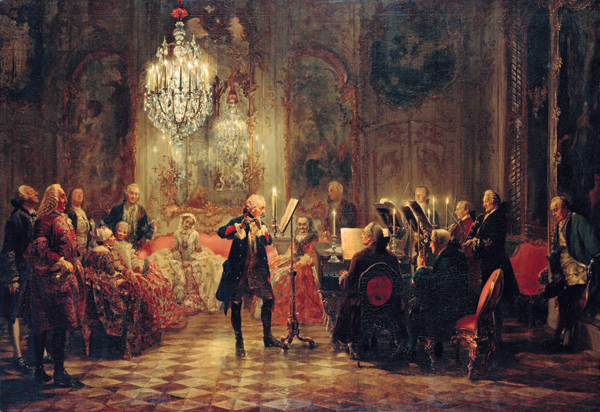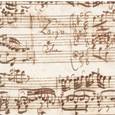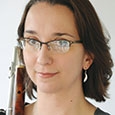
My favorite tempo marking from the Baroque period (if a person should even admit to having such a thing) is printed at the top of a Telemann trio sonata: Largo e vivace. It is a marking I especially enjoy showing to students after they have just defined largo as really, really slow, or vivace as very fast. Telemann’s marking makes more sense when we realize that the affekt, or feeling, described by these words would more accurately be translated not as slow and fast, but as broad and lively.
It is not uncommon for a word’s meaning to change over time. When a woman asks to be directed to the ladies’ room, for example, she is surely not seeking a room reserved for women of noble birth. It should come as no surprise then that musical terminology has also changed somewhat over the last 200 years. Because the Baroque period predates the invention of the metronome, the choice of tempo can require particular thought and consideration. There is always plenty of information available to us in the score, however, and tempo choices can be guided by an understanding of historically-informed style and expression, including such factors as meter, harmony, articulation and dance forms.
Baroque Notation
When we talk about the Baroque period in music, we generally mean the years from around 1600 to around 1750. Baroque composers who are especially well known to flutists include François Couperin (1668-1733), Jacques-Martin Hotteterre (1674-1763), Antonio Vivaldi (1678-1741), Georg Philipp Telemann (1681-1767), George Frederick Handel (1685-1759), Johann Sebastian Bach (1685-1750) and Johann Joachim Quantz (1697-1773).
Musical notation has evolved since the Baroque to become more specific, and composers today tend to provide a good deal more information on the page than Baroque composers did. Performers have become accustomed to composers spelling out most of the specifics of time, articulation and dynamics. The absences of some of this information in a 17th- or 18th-century score both allows and requires musicians to make informed musical decisions.
An urtext edition is a modern printing with no editorial changes made to the original manuscript. Many non-urtext modern editions of Baroque music offer extensive editorial suggestions, including dynamic shapes, articulations and metronome markings, to help fill in the gaps for modern players. Some of these editorial suggestions can be helpful and insightful, but some may be anachronistic or inappropriate. It is often difficult to differentiate between what was written by the composer and what additional markings were added by the editor. (In more recent years, publishers have made an effort to make these distinctions clearer through the use of parentheses, dashed slurs, or grayscale.)
A tempo term in a non-urtext edition of a Baroque piece may come from the composer, but a metronome marking is definitely an editor’s suggestion, and not something the composer would or could have written. It was only after Maelzel’s invention of the metronome in 1815 that composers began prescribing metronome markings in their music (although if you listen to 20th-century composers’ recordings of their own works, you will notice how often they later reject their own metronome markings). A marking added by someone other than the composer does not necessarily represent bad advice. However, knowing who wrote what simply helps in making decisions.
Tempo Markings
Tempo words are important indicators of both mood and speed, but can often be ambiguous or insufficient, and often refer only secondarily to tempo. As Robert Donington wrote, “Time words like allegro (cheerful), adagio (at ease) or grave (serious) specify a mood in order to suggest a tempo” (Donington 11). Additionally, descriptions of musical practices outlined by authors of 17th- and 18th-century treatises tended to apply mainly to their own particular time and place, so there is considerable variation and even disagreement among them, often with a lack of clear consensus about what is correct.
To illustrate some of the limitations of these markings, look at the example of largo. In modern music largo is widely thought of as either very slow or the slowest tempo, and metronomes that include tempo markings often use it to label the range between 40-60 beats per minute (placing it slower than larghetto, adagio and andante). In the Baroque period, however, largo was often defined as faster than adagio. Purcell, writing in 1683, characterized largo as faster than adagio and grave; Brossard (1703) described it as very slow; Malcolm (1721) places the tempi in order from slowest to fastest as grave, adagio, largo, vivace, allegro, presto; Grassineau (1740) calls largo “one degree quicker than grave, and two than adagio;” and Leopold Mozart, in 1756, wrote that largo was faster than grave, and slower than adagio (Donington 16). Quantz, using his own pulse as a frame of reference, assigns to adagio assai, lento, largo assai, mesto and grave the speed of quarter=20, which flutist Rachel Brown assesses as “achingly slow” (Brown 81).
One way to think more critically about tempo terminology is to look up the definition of each word in an unabridged music dictionary, even when you are certain that you already know what it means. This can clarify any other meanings or senses of the word. Dolmetsch Online (www.dolmetsch.com/musictheorydefs.htm) is a free and extremely thorough online resource. While any dictionary definition will represent only a streamlined version of all of the available information, it will still provide some clearer sense of the literal derivation of the term and of its historical evolution.
All of this means that the familiar terminology is of only limited usefulness in pinpointing a tempo in Baroque music. Quantz suggested, “The intention of the composer must be discovered instead from the content of the piece.” (Quantz 129)
Meter
The main way that a Baroque composer would indicate tempo was through the choice of meter. Time signatures with smaller note-values (a higher number) for the denominator indicated a faster speed than those with larger note values. Rachel Brown points out, for example, that J.S. Bach’s “unusual 12/16 in [the gigue of] his B minor sonata implied an extremely fast speed.” (Brown 81)
Composers like Bach used tempo words only as modifiers of the tempo indicated by the meter. Taking the 6/8 Largo e dolce of the same sonata as an example (labeled explicitly as a Siciliano dance movement in its earlier G minor version), Jed Wentz writes, “To choose a tempo based purely on the words Largo e dolce is 19th- and 20th-century performance practice. The standard practice throughout Europe in the eighteenth century was to use meter signs as tempo markings. This explains the astonishing number of meter signs in use in this period, as many as thirty-two in all, each of which had its own standard tempo and expression.” (Wentz 1) So Bach’s choice of the 6/8 meter (as opposed to 6/4 or 6/2) tells us that the movement is mostly definitely in 2, and not in a slow 6. The marking of Largo e dolce acts as a modifier of that tempo, broadening it somewhat.
Harmony
Another important tempo clue is harmonic rhythm – the rate of harmonic change, or how frequently the chords change. Generally speaking, if the harmony changes only once every measure, then the tempo should be considerably faster than if it changes every beat. In addition to harmonic rhythm, it is also good to be aware of and consider the presence of ornaments whose expressive quality is chiefly harmonic in nature (appoggiaturas, suspensions, etc.), so that the effect of their dissonance and resolution is not lost within a too-fast tempo.
Articulation and Oration
All music is expressive, but different styles and periods of music valued different kinds of expressivity and set about achieving it in different ways. Baroque composers wrote music designed to communicate feelings and to move the emotions. They wrote at great length about the similarities between music and oration. Imagine a great speech, such as John F. Kennedy’s exhortation to “Ask not what your country can do for you – ask what you can do for your country.” Would it have been more effective if he had said it much faster or twice as slow?
Because Baroque woodwind players saw a link between musical expression and oration, they used a variety of note lengths and articulation syllables within, for example, a passage of sixteenth notes. This approach creates a manner of musical expression that is closely related to speech and results in greater variety and nuance, unlike a simpler black or white choice between tonguing and slurring. Many modern editions of Baroque music add copious slurs, which obscure or eliminate this kind of expression. Excessive slurring of 16th notes tends to encourage faster tempos, and overly fast tempos in turn encourage more slurring.
Dance Forms
Basic dance skills were an important part of 17th and 18th-century social life, and it could be safely assumed at that time that anyone reading a musical manuscript would have understood the meaning of a dance title. Even in a piece intended solely for concert performance, a dance-related title would convey more information than the time signature plus Italian term. In some cases, a dance movement also has a companion mood marking, but often the dance title stands alone, with the assumption that this provided sufficient information.
The widely used Beauchamp-Feuillet system of dance notation is explained in John Weaver’s 1706 book, A Small Treatise of Time and Cadence in Dancing (see Bibliography). This notation is both visually beautiful and relatively easy to read and interpret for the purposes of obtaining musical information. Once you are acquainted with the basics of the notation, it is possible to assess such things as how many steps there are per measure, and whether the dance contains lots of turning, jumping or sliding. It is tremendously helpful to have some idea of what each dance typically looks or feels like. Sarabandes, for example, tend to feature steps where the dancer balances on the ball of one foot while tracing a loop with the other foot, over the course of two beats. An overly slow tempo can make this motion awkward and ungainly. There are instructional DVDs available, such as the ones produced by Paige Whitley-Bauguess (see Bibliography), that feature excellent professional demonstrations of common dance types.
Other Factors
There is ample evidence that Baroque musicians addressed problems of musical performance in highly practical ways. Several sources suggest taking the acoustic of the performing space into consideration, a larger or more live room requiring more time than a smaller or drier one. Similarly, we should bear in mind today that recordings reflect a very different set of circumstances from a live performance, including close positioning of the microphone[s], and often a comparatively dry acoustic. The fast tempo that sounds wonderful when listening to a recording on headphones may not work at all in an auditorium, in a room with some ring, or with an audience spaced throughout a larger room. C.P.E. Bach further advised that we pay particular attention to busy technical passages: “The pace of a composition, which is usually indicated by several well-known Italian expressions, is based on its general content as well as on the fastest notes and passages contained in it. Due consideration of these factors will prevent an allegro from being rushed and an adagio from being dragged” (C.P.E. Bach 151).
While there may not be a standard set of simple answers to questions of tempo, asking the right kinds of questions can lead to a fine, expressive and well thought-out performance. It is most important to engage cheerfully with the complexity, and to know that there is leeway and artistic license to find tempos that truly work for you, the music, and the audience.
Bibliography
Bach, Carl Philipp Emanuel. Essay on the True Art of Playing Keyboard Instruments. Translated by William J. Mitchell. New York: W. W. Norton & Company, 1949.
Brown, Rachel. The Early Flute: A Practical Guide. Cambridge: Cambridge University Press, 2002.
Donington, Robert. Baroque Music Style and Performance: A Handbook. London: W. W. Norton & Company, 1982.
Hilton, Wendy. Dance and Music of Court and Theater: Selected Writings of Wendy Hilton. Stuyvesant, New York: Pendragon Press, 1997.
Hotteterre, Jacques-Martin. Principles of the Flute, Recorder and Oboe. Translated by Paul Marshall Douglas. New York: Dover Publications, Inc., 1968.
Mather, Betty Bang, and Dean M. Karns. Dance Rhythms of the French Baroque. Bloomington: Indiana University Press, 1987.
Powell, Ardal, ed. TRAVERSO Historical Flute Newsletter: The Second Decade, 1999-2008. Hillsdale, New York: Pendragon Press, 2009. (Newsletter subscriptions available through www.traversonewsletter.org)
Quantz, Johann Joachim. On Playing the Flute. Translated by Edward R. Reilly. New York: Schirmer Books, 1985.
Weaver, John. A Small Treatise of Time and Cadence in Dancing. Translated from the French of Feuillet. London: Gregg International Publishers Limited, 1971. (Out of print, but available in many university libraries, or through inter-library loan.)
Wentz, Jed. “Bach: Quick Tempi and Passionate Expression” TRAVERSO 5/3 (July 1993), 1-3.
Whitley-Bauguess, Paige. Introduction to Baroque Dance (DVD). (Available through www.baroquedance.com)
www.bach-digital.de – Searchable database with high-resolution digital images of J. S. Bach original manuscripts.






